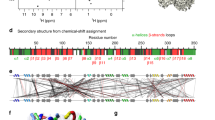Abstract
THE considerable interest attached to conformational studies of gramicidine S has resulted from the use of this compound as a model for computations of polypeptide conformations. Two conformations have been postulated from energy considerations: Vanderkooi et al.1 have postulated a compact conformation for gramicidine S in which two identical pairs (L val–L orn) of the ten amino-acids of this cyclic peptide form a short length of anti-parallel extended β-conformation while the conformation postulated by Liquori et al.2 is quite different in that the two identical segments (L val–L orn–L leu) form segments of a right handed α-helix. Spectroscopic techniques such as optical rotatory dispersion and infrared which have been applied with success to conformational analysis of synthetic homopolypeptides and proteins have given inconclusive results when applied to gramicidine S; this results from the cyclic form of this peptide and the fact that any regular structure, if present, can only involve a very small number of residues. Liquori and Conti3 have attempted to adduce evidence from NMR spectroscopy in favour of the conformation2 for gramicidine S by comparison of the chemical shifts of the αCH protons with those of synthetic homopolymers. The salient point made by Liquori et al. from unpublished results is that “the chemical shift of an αCH proton in a homopolypeptide seems to be strongly dependent on the backbone conformation of the ammo-acid residues, to a smaller extent on the nature and conformation of the side chains and it is fairly insensitive to the solvent”. Thus by comparison of the chemical shifts of the αCH protons of gramicidine S in dimethyl sulphoxide with those of the helical forms of poly L-leucine in trifluoroacetic acid/deuterochloroform (TFA/CDCl3) mixtures and poly L-ornithine in D2O, they deduce that there are helical segments in gramicidine S. We are not concerned here with the correctness or otherwise of the theoretically predicted conformations of gramicidine S, but would like to demonstrate from our experimental NMR studies of polypeptides that considerable difficulties are involved if the chemical shift of the αCH peak is used in a simple manner for conformational analyses of polypeptides.
This is a preview of subscription content, access via your institution
Access options
Subscribe to this journal
Receive 51 print issues and online access
$199.00 per year
only $3.90 per issue
Buy this article
- Purchase on Springer Link
- Instant access to full article PDF
Prices may be subject to local taxes which are calculated during checkout
Similar content being viewed by others
References
Vanderkooi, G., Leach, S. J., Nemethy, G., and Scheraga, H. A., Biochemistry, 5, 2991 (1966).
Liquori, A. M., De Santis, P., Kovacs, A. L., and Mazzarella, L., Nature, 211, 1039 (1966).
Liquori, A. M., and Conti, F., Nature, 217, 635 (1968).
Downie, A. R., Elliott, A., Hanby, W. E., and Malcolm, B. R., Proc. Roy. Soc., A, 242, 325 (1957).
Bradbury, E. M., Carpenter, B. G., and Goldman, H., Biopolymers, 6, 837 (1968).
Moffitt, W., and Yang, J. T., Proc. US Nat. Acad. Sci., 42, 596 (1956).
Ferretti, J. A., Chem. Commun., 1030 (1967).
Bradbury, E. M., Crane-Robinson, C., Goldman, H., and Rattle, H. W. E., Nature, 217, 812 (1968).
Markley, J. L., Meadows, D. H., and Jardetzky, O., J. Mol. Biol., 27, 25 (1967).
Tsuboi, M., Mitsui, Y., Wada, A., Miyazawa, T., and Nagashima, N., Biopolymers, 1, 297 (1963).
Sternlicht, H., and Wilson, D., Biochemistry, 6, 2881 (1967).
Bradbury, E. M., Downie, A. R., Elliott, A., and Hanby, W. E., Proc. Roy. Soc., A, 259, 110 (1960).
Karlson, R. H., Norland, K. S., Fasman, G. D., and Blout, E. R., J. Amer. Chem. Soc., 82, 2268 (1960).
Bradbury, E. M., Crane-Robinson, C., and Rattle, H. W. E., Nature, 216, 862 (1967).
Hashimoto, M., and Aritomi, J., Bull. Chem. Soc. Japan, 39, 2707 (1966).
Goodman, M., Boardman, F., and Litowsky, I., J. Amer. Chem. Soc., 85, 2491 (1963).
Wada, A., J. Mol. Biol., 3, 507 (1961).
Bradbury, E. M., Crane-Robinson, C., Goldman, H., and Rattle, H. W. E., Biopolymers, 6, 851 (1968).
Ooi, T., Scott, R. A., Vanderkooi, G., and Scheraga, H. A., J. Chem. Phys., 46, 4410 (1967).
Author information
Authors and Affiliations
Rights and permissions
About this article
Cite this article
BRADBURY, E., CARPENTER, B., CRANE-ROBINSON, C. et al. Application of High Resolution Nuclear Magnetic Resonance to Conformational Analyses of Polypeptides in Solution. Nature 220, 69–72 (1968). https://doi.org/10.1038/220069b0
Received:
Issue Date:
DOI: https://doi.org/10.1038/220069b0
This article is cited by
Comments
By submitting a comment you agree to abide by our Terms and Community Guidelines. If you find something abusive or that does not comply with our terms or guidelines please flag it as inappropriate.



